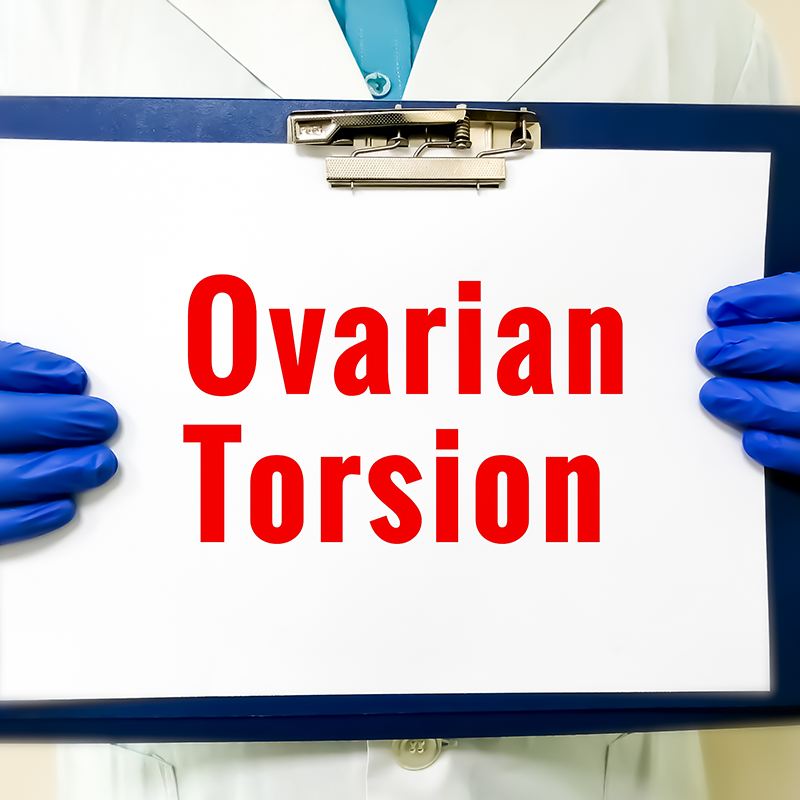
Lucy was only 17 when she began experiencing pain and tenderness in her abdomen. Her primary doctor chalked it up to PMS. However, her abdominal pain soon became so severe that her mom took her to an OB/GYN for an exam. It was there that Lucy was diagnosed with ovarian torsion.
What is Ovarian Torsion?
Ovarian torsion is a condition that occurs when an ovary twists around the ligaments that hold it in place. This twisting can cut off blood flow to the ovary and fallopian tube, which can result in severe pain and organ damage.
Ovarian torsion is difficult to recognize since the only physical indicators are abdominal pain, cramps and pelvic pain. Because the symptoms closely mimic PMS, you’ll only know that something is wrong by the pain and tenderness in your abdomen. It can be easy to dismiss these symptoms but you should never wait to seek help in cases of severe, sudden pain.
Symptoms of Ovarian Torsion
The most common symptom of ovarian torsion is sudden abdominal pain. You’ll feel an occasional but sharp pain and you may also feel nauseous. You may even vomit as a result of the pain.
Other symptoms include:
- Tender abdomen
- Abdominal and/or pelvic cramps
- Pelvic pain
Cramps may last a few days or even weeks. This occurs when your ovary is twisting and untwisting constantly. Pain may also go into your back or legs. The amount of pain you feel can depend on whether you are perimenopausal or post-menopausal.
Severe Ovarian Torsion
If you have a fever, your ovary may be necrotic and will need to be removed. This is considered a severe case and you must seek treatment immediately. You may also experience abnormal bleeding from your vagina, as well as discharge. If your abdomen or pelvic area is rigid or in pain when you stop touching your abdomen, you may already have a necrotic ovary. Your doctor may do a pelvic exam to feel for other problems and tenderness.
Who is Most Likely to Experience Ovarian Torsion?
Ovarian torsion is most likely to happen to women during their reproductive years. However, it can also occur in children and women who are post-menopausal.
Pregnancy can also put you at risk. Roughly 20% of ovarian torsion cases occur in pregnant women.
Women who are on fertility or hormone treatments can also be at risk since hormonal medication can cause cysts to grow on your ovaries. These cysts and masses can put your ovaries at a higher risk for twisting around themselves.
Treating Ovarian Torsion
Surgery is the only treatment for ovarian torsion. Your doctor will recommend one of the following two surgeries.
Laparoscopic Surgery – Laparoscopic surgery is considered minor. Your doctor will make an incision in your abdomen and insert a thin tube with a camera on the end called a laparoscope. He or she will then untwist the ovary and if necessecary, will untwist your fallopian tube, too.
Laparotomy Surgery – Laparotomy surgery is an open surgery. This type of surgery is more invasive and requires anesthesia and an overnight stay. This surgery is performed by making an incision in your abdomen and assessing your reproductive organs. If possible, any present masses will be untwisted and removed.
If you experience severe ovarian torsion, meaning your blood supply was cut off from your fallopian tubes or ovaries, they will most likely need to be removed.
Seek Immediate Medical Attention if You Suspect Ovarian Torsion
If you experience sudden abdominal or pelvic pain, seek immediate medical attention, as you could be experiencing ovarian torsion. Seeking help immediately will not only help relieve your pain quicker, but it may also keep you from having to get your reproductive organs removed.
Ovarian torsion can happen at any age. Thankfully, Lucy received help immediately and was successfully treated.
Our board-certified OB/GYNs can help if you suspect any issues. Make an appointment today by calling 770.720.7733 or request an appointment online.


